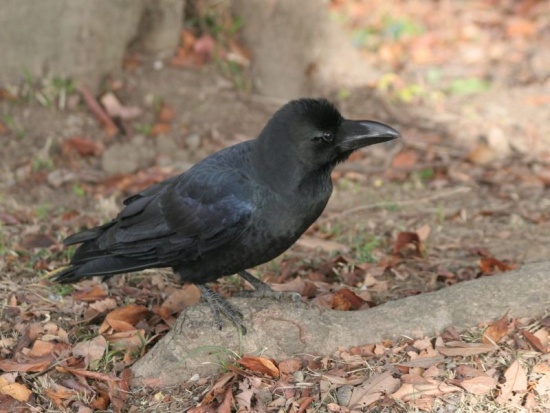(behaviour, habitat) |
(distribution, references) |
||
| Line 8: | Line 8: | ||
46-59 cm. Long bill with the upper one quite thick and arched, making it look heavy. Dark greyish plumage from the back of the head, neck, shoulders and lower body. Their wings, tail, face and throat are glossy black. The depth of the grey shading varies across its range to almost black in the Indian form. | 46-59 cm. Long bill with the upper one quite thick and arched, making it look heavy. Dark greyish plumage from the back of the head, neck, shoulders and lower body. Their wings, tail, face and throat are glossy black. The depth of the grey shading varies across its range to almost black in the Indian form. | ||
==Distribution== | ==Distribution== | ||
| − | [[Asia]], | + | Found in south and east [[Asia]].<br /> |
| + | From [[Afghanistan]] over the [[India]]n Subcontinent, the [[Himalayas]] and central, south and east [[China]] to [[Korea]], the far east of [[Russia]] to [[Japan]]. Also to [[Burma]], [[Thailand]], [[Indochina]], peninsular [[Malaysia]] to [[Sumatra]], [[Java]], [[Borneo]] and the Sundas to [[Timor]] and Wetar. A regional form occurs on the [[Philippines]].<br /> | ||
| + | Common and widespread in most of its range. Rather rare in [[Borneo]]. Records from [[Iran]], north [[Afghanistan]], [[Turkmenistan]] and [[Tajikistan]] are probably erroneous. | ||
==Taxonomy== | ==Taxonomy== | ||
There are eleven subspecies in this taxon which could be split into several species in the future: | There are eleven subspecies in this taxon which could be split into several species in the future: | ||
| Line 35: | Line 37: | ||
The nest is a platform of twigs, usually high up on a tree with a preference for tall conifers like Fir or Pine. There are normally 3-5 eggs laid and they are incubated for 17-19 days. The young are fledged usually by about the 35th day. <br /> | The nest is a platform of twigs, usually high up on a tree with a preference for tall conifers like Fir or Pine. There are normally 3-5 eggs laid and they are incubated for 17-19 days. The young are fledged usually by about the 35th day. <br /> | ||
A resident species. Birds of northern populations move to the coast (ice-free river-mouths) in winter. | A resident species. Birds of northern populations move to the coast (ice-free river-mouths) in winter. | ||
| + | ==References== | ||
| + | #{{Ref-Clements6thDec08}}#{{Ref-HBWVol14}}#{{Ref-RasmussenAnderton05}} | ||
| + | {{Ref}} | ||
==External Links== | ==External Links== | ||
{{GSearch|Corvus+macrorhynchos}} | {{GSearch|Corvus+macrorhynchos}} | ||
[[Category:Birds]][[Category:Corvus]] | [[Category:Birds]][[Category:Corvus]] | ||
Revision as of 17:24, 10 March 2010
- Corvus macrorhynchos
Identification
46-59 cm. Long bill with the upper one quite thick and arched, making it look heavy. Dark greyish plumage from the back of the head, neck, shoulders and lower body. Their wings, tail, face and throat are glossy black. The depth of the grey shading varies across its range to almost black in the Indian form.
Distribution
Found in south and east Asia.
From Afghanistan over the Indian Subcontinent, the Himalayas and central, south and east China to Korea, the far east of Russia to Japan. Also to Burma, Thailand, Indochina, peninsular Malaysia to Sumatra, Java, Borneo and the Sundas to Timor and Wetar. A regional form occurs on the Philippines.
Common and widespread in most of its range. Rather rare in Borneo. Records from Iran, north Afghanistan, Turkmenistan and Tajikistan are probably erroneous.
Taxonomy
There are eleven subspecies in this taxon which could be split into several species in the future:
- Japonensis group
- C. m. intermedius in east Afghanistan, Pakistan, along the Himalayas to south Tibet and north Nepal
- C. m. tibetosinensis in Tibet, eastern Himalayas (east from Bhutan), north Burma and extreme south China
- C. m. mandshuricus in the Russian Far East, Korea, Sakhalin and northeast China
- C. m. japonensis in Japan and south Sakhalin
- C. m. connectens on Amami Oshima and Ryukyu Island (Japan)
- C. m. osai on southern Ryukyu Islands
- Levaillantii group
- Macrorhynchos group
- Philippinus group
- C. m. philippinus in Philippines
More subspecies are proposed but usually not accepted. The taxonomy of this species is not yet solved.
Habitat
Woodland, parks and gardens. In north of range often near rivers and settlements near rivers.
Up to 2000 m in Sri Lanka, 4500m in Sikkim and 5000m in Tibet. Known to follow mountaineers as high as 6400m.
Behaviour
Feeds on carrion of all kinds. Forages along shorelines and roadsides, robs bird nests, steals food from vulture nests, kills palm-squirrels and rodents, frogs, lizards, crabs and insects. Takes also fruit, nectar and petals.
Usually seen in pairs or family parties, often associating with other birds like House Crow.
The nest is a platform of twigs, usually high up on a tree with a preference for tall conifers like Fir or Pine. There are normally 3-5 eggs laid and they are incubated for 17-19 days. The young are fledged usually by about the 35th day.
A resident species. Birds of northern populations move to the coast (ice-free river-mouths) in winter.
References
- Clements, JF. 2008. The Clements Checklist of Birds of the World. 6th ed., with updates to December 2008. Ithaca: Cornell Univ. Press. ISBN 978-0801445019.
- Del Hoyo, J, A Elliott, and D Christie, eds. 2009. Handbook of the Birds of the World. Volume 14: Bush-shrikes to Old World Sparrows. Barcelona: Lynx Edicions. ISBN 978-8496553507
- Rasmussen, PC and JC Anderton. 2005. Birds of South Asia: The Ripley Guide. Barcelona: Lynx Edicions. ISBN 978-8487334672
Recommended Citation
- BirdForum Opus contributors. (2025) Large-billed Crow. In: BirdForum, the forum for wild birds and birding. Retrieved 28 April 2025 from https://www.birdforum.net/opus/Large-billed_Crow







